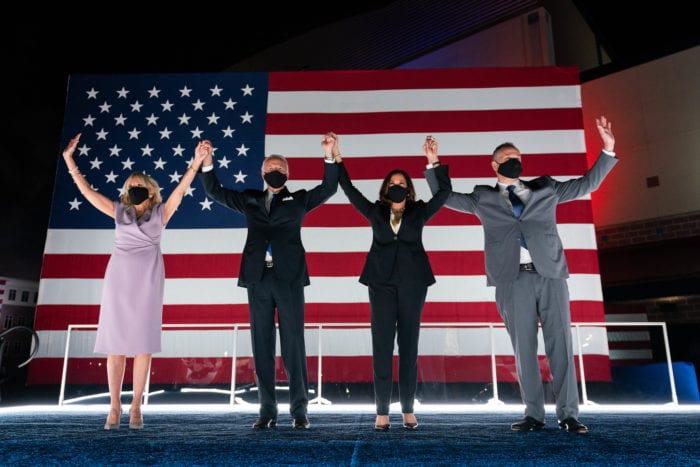
“There’s always a little bit of a social tendency to say they’d done it when maybe it’s in the mailbox”
A blue wave? It ebbed against a Republican shoreline.
Democrat victories in red states like Florida and Texas? Both were called early for President Trump.
In the end, Democrats barely held on to a majority in the House, they’re counting on two runoff victories in Georgia to take the Senate, and as for the presidency, the General Services Administration did not sign off on the start of Joe Biden’s transition until Nov. 23.
After the 2016 election resulted in some second-guessing of the polls, now similar questions are being raised about how the pollsters could have made some errant predictions again. Based on conversations with experts in the Boston area, it seems like predicting the unpredictable was once again their dilemma this time around.
One source of unpredictability in American politics the last few years has been President Trump. The phenomenon of the “shy Trump voter” entered the American lexicon, although experts said that in the end, it wasn’t as sizable as sometimes made out to be.
“We did not feel he had enough to win,” said David Paleologos, director of the Suffolk University Political Research Center. “It’s kind of what happened. There were shy voters in the blue wall states. I think there were more in 2016.”
“The candidate was very unpredictable,” Paleologos said. “It also happens if people feel that a candidate represents qualities that are polarizing and distasteful.”
Yet the difficulty of gauging support for the incumbent went beyond shy Trump voters.
“I think the most likely candidate is that in the presidential year, we apparently saw some fraction of Trump supporters just not respond to the polls,” said Charles Stewart III, director of the Stanford-MIT Healthy Elections Project and of the MIT Election Lab. “It was not the ‘shy Trump supporter’ phenomenon, but what’s called a nonresponse bias.” And, Stewart said, “You did not need a whole lot of Trump supporters not responding to create the errors we’re seeing.”
Paleologos reflected on the challenge of “a slice of electorate that is not comfortable giving you information.”
“If you say you’re undecided, they can’t mark you down as a Trump voter,” he explained. “I can look at the data. [Someone said they were] undecided between Trump and Biden. They said they don’t like Biden and are unsure about Trump. They gave Trump high job approval. I can say they’re probably a Trump voter but I can’t change the data. We have to assume they are undecided.”
Trump complicated the situation in other ways, including with last-minute, COVID-defying rallies.
“It seemed for close to two weeks, he was feverishly barnstorming,” said Thomas Patterson, the Bradlee Professor of Government and the Press at Harvard Kennedy School. “He seemed to have some ability to mobilize Republicans who may not have voted otherwise. In the pollster model, they may look like nonvoters, given the responses they made.”
The last-ditch Trump get-out-the-vote effort occurred just as the polls were winding down their final tallies.
“It’s no good to do a poll Tuesday morning,” Patterson said of Election Day. “They always miss the last day or two. … It’s pretty clear from the exit polls that Trump got a disproportionate number of the late deciders,” picking up an estimated difference of close to a point.
Despite his controversiality—or because of it?—he captured almost 95% of Republican voters, a two-point improvement upon 2016. And if there were shy Trump voters, there were also Trump voters who were anything but. Pollster Paleologos said that some individuals told pollsters that they were “proud to state that” they liked Trump.
Another unpredictability looming over the election was not a candidate but a virus: COVID-19. The ways in which people could vote suddenly multiplied to include mail-in ballots and early voting as well as the traditional in-person vote on Election Day. The mail-in ballots have drawn criticism from Trump since they were first offered as an alternative to voters concerned about casting a ballot during the pandemic.
“Perhaps mail-in voting and early voting may have affected the results,” Patterson said, positing that a respondent may have told a pollster that they already voted but had not. “There’s always a little bit of a social tendency to say they’d done it when maybe it’s in the mailbox.”
Between the flood of mail-in ballots and the evaporated blue wave, maybe it’s hard to remember the last time the pollsters were questioned so thoroughly, in 2016. Well, the pollsters do remember those days.
“The national polls in 2016 were not wrong,” Paleologos reflected. “The RealClearPolitics average had Hillary Clinton winning the popular vote by three points. She ended up winning by two points. The national polls were closer four years ago than this time. This time, the national polls were a little far farther off. They had Biden winning by higher than what happened in 2016.
“In the blue wall states—specifically Michigan, Wisconsin, Pennsylvania—the polls were far off. Anyone polling those states got the scrutiny.”
Paleologos and other experts said that inexperienced state pollsters misfired on calling individual states four years ago.
“There were polls in 2016 done in blue wall states,” he said. “They were not top-rated public university pollsters with access to 538.com, Nate Silver, his rating system.”
“There were bad state polls in 2016,” said MIT’s Stewart. “They had a tendency to overestimate Hillary Clinton votes.” He added, “Simply, state polls were more likely to be made by people new to the field. There were a lot of start-up state polls in 2016. They did not have the experience necessary, the research necessary, to do state polling correctly.”
He notes, “That does not explain 2020,” when there are “a number of state polling organizations that are really quite established.”
It’s one more reflection of what made this election so unpredictable, even for those whose job is to predict it.
“We take the temperature of the popular vote or state vote,” Paleologos said. “It’s increasingly complex and challenging because the nation is so divided.
“In our last national poll, one of our most significant findings, bigger than 2016, is that 66% feel the divisions in our country are greater than they’ve ever been before. It’s probably the right number. Democrats and Republicans both agree the divisions are so deep. It’s why Biden talks about healing so much in his speeches since the election. The divide has the potential to deepen. Ultimately, the country has to reconcile the differences.”
Rich Tenorio is a writer and editor whose work has appeared in international, national, regional and local media outlets. He is a graduate of Harvard College and the Columbia University Graduate School of Journalism. He is also a cartoonist.

